The use of captured German rifles and machine guns in the USSR
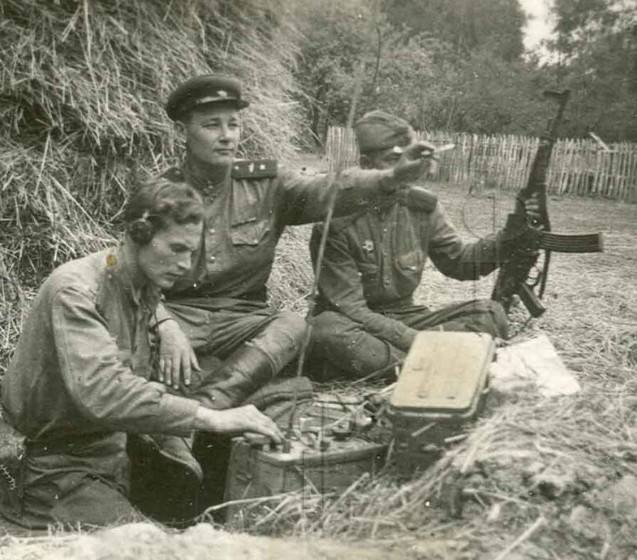
By the time of the attack on the USSR, the actions of the Wehrmacht infantry squad were built around the MG34 machine gun, which was served by three people. Non-commissioned officers could be armed with MP28 or MP38 / 40 submachine guns, and six shooters with K98k rifles.
Magazine rifle K98k
During World War II, the bulk of the German infantrymen were armed with 7,92 mm Mauser 98k rifles, which in German sources were designated Karabiner 98k or K98k. In that weaponsadopted in 1935, the successful solutions of the Standardmodell rifles (Mauser Model 1924/33) and the Karabiner 98b were used, which, in turn, were developed on the basis of the Gewehr 98. Despite the name Karabiner 98k, this weapon was actually a full-fledged rifle and was not much shorter our "Mosinka".
Compared to the original Gewehr 98, which entered service in 1898, the improved K98k rifle had a shorter barrel (600 mm instead of 740 mm). The length of the box was slightly reduced, and a recess appeared in it for the bolt handle bent down. Instead of the "infantry" Gewehr 98 swivels on the K98k, the front swivel is combined into one piece with the rear stock ring, and instead of the rear swivel there is a through slot in the butt. After loading the magazine with cartridges, it began to be ejected when the shutter was closed. A new SG 84/98 bayonet was introduced, significantly shorter and lighter than the bayonets provided for the Mauser 98. The K98k rifle was equipped with a short ramrod. In order to clean the bore, two cleaning rods must be screwed together. The wooden stock has a semi-pistol grip. The steel butt plate is made with a door that closes the compartment for accessory to weapons. In order to reduce the cost of manufacturing, after Germany entered the war, wooden parts were replaced with plywood.
Depending on the version and year of production, the mass of the rifle was 3,8-4 kg. Length - 1110 mm. For firing from the K98k, the 7,92 × 57 mm sS Patrone cartridge was usually used, originally developed for use at long distances, with a heavy pointed bullet weighing 12,8 g. The muzzle velocity of the bullet was 760 m / s. Muzzle energy - 3700 J. An integral two-row box magazine with a capacity of 5 rounds is located inside the box. The magazine is loaded with cartridges with the bolt open through the wide upper window in the receiver from clips for 5 rounds or one cartridge each. Sights consist of a front sight and a sector rear sight, adjustable in firing range from 100 to 1000 meters.
A well-trained shooter is capable of firing 12 aimed shots per minute. The effective firing range with mechanical sights was 500 m. A sniper rifle with a telescopic sight could hit targets at a distance of up to 1000 m. Rifles with the best accuracy of combat were selected to install telescopic sights.
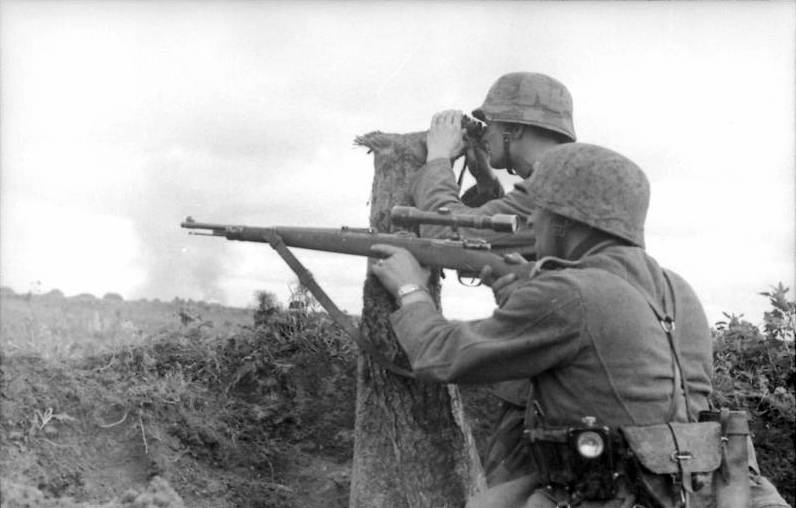
Shooter armed with a K98k rifle with a ZF39 telescopic sight mounted on it
The most commonly used were the fourfold ZF39 sights or the simplified 41X ZF1943. In 43, the ZF132 fourfold telescopic sight was adopted. In total, about 000 sniper rifles were produced for the German armed forces.
During World War II, the Gewehrgranat Geraet 42 rifle grenade launcher was introduced, which was a 30 mm mortar attached to the muzzle of the rifle. The cumulative grenades were fired with a blank cartridge. Sighting range of cumulative anti-tank grenades was 40 m, normal armor penetration - up to 70 mm.
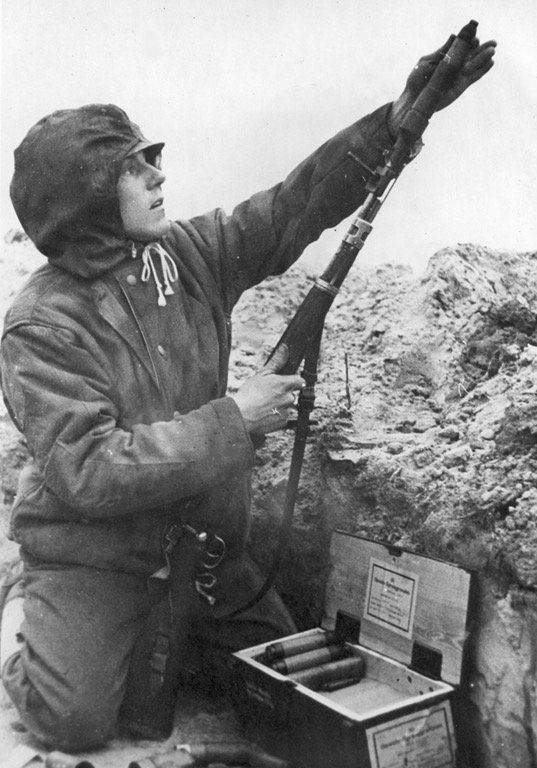
German infantryman loading a rifle grenade
In addition to a mortar for firing grenades, a HUB23 muffler could be attached to the muzzle of the rifle, paired with a special Nahpatrone cartridge. Ammunition with an initial bullet speed of 220 m / s ensured a confident defeat of a growth target at a distance of up to 200 m.
In late 1944, production of a simplified version of the K98k, known as the Kriegsmodell ("military model"), began. This modification had a number of changes aimed at reducing the cost and labor intensity of production with some deterioration in the quality of manufacture and finishing. The resource of the barrel also decreased, and the accuracy of shooting deteriorated. The production of K98k rifles was carried out at ten enterprises in Germany, Austria and the Czech Republic. In total, from 1935 to 1945, more than 14 million rifles were delivered to the customer.
The K98k rifle is one of the finest bolt action magazine rifles. It has high reliability, durability and long service life, simplicity and safety in handling. During World War II, K98k rifles were widely used by all branches of the German armed forces in all theaters of war where German troops took part. However, with all its positive qualities, by the beginning of the 1940s, the K98k rifle as an individual infantryman's weapon no longer fully met the requirements. She did not have the required rate of fire and was a relatively bulky and heavy weapon for warfare in populated areas. The rate of fire was limited by how quickly the shooter could operate the bolt and load a 5-round magazine. However, these shortcomings were common to all magazine rifles without exception. In part, the low combat rate of fire of the K98k was compensated by the fact that the Germans relied not on rifles, but on single machine guns to provide the unit's firepower.
Although, according to weapons experts, the German MG-34/42 were the most successful machine guns of the Second World War, the bet on them as the basis of the squad's firepower was not always justified. For all their advantages, these German machine guns were quite expensive and difficult to manufacture, and therefore there was always a shortage of them at the front. The use of machine guns captured in the occupied countries only partially solved this problem. And the submachine guns had high firepower, but had a short range. Given the saturation of all types of troops with automatic weapons, it was highly desirable to equip the infantry with a rifle superior in rate of fire to the K98k.
Self-loading and automatic rifles
At the end of 1941, self-loading rifles of two types entered the active army for military trials: G41 (W) and G41 (M), which were very similar in appearance. The first was developed by Carl Walther Waffenfabrik, the second by Waffenfabrik Mauser AG. The rifle automation worked by removing part of the powder gases. The self-loading rifles used the same ammunition as the K98k magazine rifle. Both rifles failed tests and were sent for revision.
Rifles G41 (W) and G41 (M) proved to be dust sensitive. Their moving parts had to be heavily greased. As a result of powder soot, the sliding parts were stuck together, which made disassembly difficult. Burning of the flame arrester was often noted. There were complaints about overweight and poor shooting accuracy.
In 1942, after military trials, the G41 (W) rifle entered service. It was produced at the Walther plant in Zella-Melis and at the Berlin-Lübecker Maschinenfabrik plant in Lübeck. More than 100 copies were made according to American data.
The weight of the rifle without cartridges was 4,98 kg. Length - 1138 mm. Barrel length - 564 mm. Bullet muzzle velocity - 746 m / s. Combat rate of fire - 20 rounds / min. Food was supplied from an integral 10-round magazine. Effective firing range - 450 m, maximum - 1200 m.
But, despite the adoption and launch into mass production, many of the shortcomings of the G41 (W) were never eliminated, and in 1943 the production of the modernized G43 rifle began. In 1944, it was renamed the Karabiner 43 carbine (K43). On the G43, the unsuccessful gas vent assembly was replaced with a design borrowed from the Soviet SVT-40 rifle. Compared to the G41 (W), the G43 has improved reliability and also reduced weight. A significant part of the parts were made by casting and stamping, the outer surface was very rough.
The weight of the G43 rifle without cartridges is 4,33 kg. Length - 1117 mm. Food - from a detachable magazine for 10 rounds, which could be replenished with clips for 5 rounds without removing it from the weapon. Some of the rifles had a 25-round box magazine from the MG13 light machine gun. Thanks to the use of detachable magazines, the combat rate of fire increased to 30 rounds / min.
The production of G43 rifles was established at the enterprises that previously produced the G41 (W). By March 1945, a little more than 402 self-loading rifles were delivered. According to the plans of the German command, each grenadier (infantry) company of the Wehrmacht was supposed to have 000 self-loading rifles. However, this has not been achieved in practice.
Approximately 10% of the G43s had telescopic sights, but the G43 sniper rifles were significantly inferior in firing accuracy to the K98k rifles. However, in street battles, where the firing range in most cases was not great, the G43 with sniper sights performed well.
A very unusual German automatic rifle is the FG42 (German: Fallschirmjägergewehr 42 - paratrooper's rifle, model 1942). This weapon, created for the Luftwaffe paratroopers, also entered service with mountain rifle units. Single copies of the FG42 were at the disposal of the most experienced soldiers of the Wehrmacht and the SS troops.
The FG42 rifle automatics works by diverting a part of the powder gases through a transverse hole in the barrel wall. The barrel bore was locked by turning the bolt, which occurs as a result of the interaction of the curvilinear groove on the bolt and the beveled planes on the bolt carrier when the latter moves. Two lugs are located symmetrically in front of the bolt. The stock contains a buffer that reduces the impact of recoil on the shooter. When firing, cartridges are fed from a box magazine with a capacity of 20 cartridges with a two-row arrangement, mounted on the left side of the rifle. The striker-type trigger mechanism allows single and automatic fire.
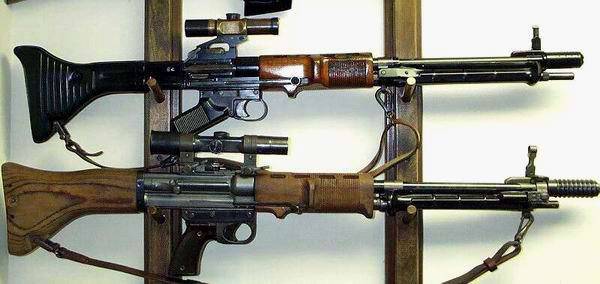
Automatic rifles FG42 / 1 and FG42 / 2
The first modification FG42 / 1 had many disadvantages: low strength, low reliability, and insufficient resource. Shooters complained about the high probability of hitting spent cartridges in the face, uncomfortable holding of the weapon and poor stability when firing. Taking into account the identified comments, a more reliable, safe and convenient automatic rifle FG42 / 2 was developed. However, the cost of making the rifle was very high. In order to optimize the production process and save scarce materials, it was planned to switch to the use of stamping from steel sheet. It was necessary to reduce production costs, since, for example, the laborious milled receiver was made of very expensive high-alloy steel. Due to delays caused by the need to eliminate deficiencies, the Krieghoff company began to manufacture a batch of 2000 rifles only at the end of 1943. During series production, improvements were made to the FG42 design to reduce costs, improve usability and reliability. The last serial modification was the FG42 / 3 (Type G) with a stamped receiver.
Although the FG42 / 3 rifle remained expensive and difficult to manufacture, it had very high performance and was quite reliable. The barrel and butt were on the same line, due to which there was practically no recoil shoulder, which minimized the throwing of the weapon when firing. To a large extent, the recoil was reduced by a massive compensator-flash suppressor, attached to the muzzle of the barrel. The sights consisted of a front sight fixed to the barrel and an adjustable rear sight placed on the receiver. Most of the serial rifles were equipped with optical sights. For close combat, the rifle is equipped with an integral quadrangular needle bayonet, which in the stowed position leans back and is located parallel to the barrel. FG42 was equipped with folding light stamped bipods.
The mass of the weapon of the late modification without cartridges was 4,9 kg. Length - 975 mm. Barrel length - 500 mm. Bullet muzzle velocity - 740 m / s. Effective range with a mechanical sight - 500 m. Rate of fire - 750 rounds / min.
For a number of reasons in Germany, it was not possible to establish the mass production of the FG42. In total, about 14 copies were made. The FG000 automatic rifle began to enter the troops too late in order to fully demonstrate its combat qualities and advantages. Nevertheless, the FG42 is an interesting and unique automatic rifle and one of the most interesting weapons designed and produced in the Third Reich.
Intermediate automatic assault rifles
Even before the start of the Second World War, it became clear to designers and the military in different countries that rifle cartridges were too powerful to solve most of the tasks inherent in individual infantry weapons. In 1940, the designers of Polte Armaturen-und-Maschinenfabrik AG, on their own initiative, created a cartridge with a dimension of 7,92 × 33 mm, which after being put into service received the designation 7,9 mm Kurzpatrone 43 (7,9 mm Kurz). This ammunition in terms of energy occupied an intermediate position between the 9 mm Parabellum pistol cartridge and the 7,92 mm Mauser rifle cartridge.
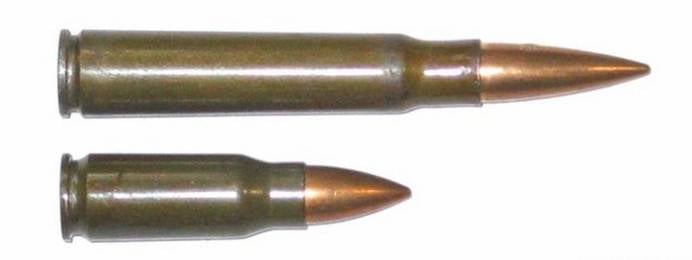
Cartridges 7,92 × 57 mm and 7,92 × 33 mm
The steel sleeve 33 mm long was bottle-shaped and varnished to prevent corrosion. Serial ammunition 7,9 mm Kurz SmE weighed 17,05 g. Bullet weight - 8,1 g. Muzzle energy - 1900 J.
Under the 7,9 mm Kurz cartridge, a number of assault rifles (assault rifles) were developed in the Third Reich, some of which were brought to the stage of mass production. In July 1942, an official demonstration of assault rifles for the intermediate cartridge Maschinenkarabiner 42 (H) (MKb 42 (H)) and Machinenkarabiner 42 (W) (MKb42 (W)) took place. The first was developed by CG Haenel, the second by Carl Walther Waffenfabrik. The automation of both samples was based on the principle of removing part of the powder gases.
The winner of the competition was revealed by military trials on the Eastern Front. According to their results, subject to the elimination of a number of shortcomings and the introduction of certain changes in the design, the MKb42 (H) was recommended for adoption. As changes were made to the design of the bolt, firing mechanism and gas outlet assembly, the MP43 / 1 and MP43 / 2 “submachine guns” were born. In June 1943, serial production of the MP 43/1 began. Until December 1943, when this model was replaced by a more advanced modification at production facilities, more than 12 copies of the MP 000/43 were produced. Even at the design stage of the weapon, much attention was paid to its manufacturability and cost reduction, for which stamping was used in the manufacture of the receiver and a number of other parts.
Mass use of the MP43 on the Eastern Front began in the fall of 1943. At the same time, it was found that the new machine gun combines the positive qualities of submachine guns and rifles, which makes it possible to increase the firepower of infantry units and reduces the need for light machine guns.
After receiving a positive opinion from the army in the field, an official decision was made to adopt a new machine gun into service. In April 1944, the name MP43 was changed to MP44, and in October 1944 the weapon received the final name - StG 44 (German Sturmgewehr 44 - "Assault rifle 44").
The mass of the unloaded weapon was 4,6 kg, with an attached magazine for 30 rounds - 5,2 kg. Length - 940 mm. Barrel length - 419 mm. Bullet muzzle velocity - 685 m / s. The effective range for single shots is up to 600 m. The rate of fire is 550-600 rounds / min.
In general, the StG 44 assault rifle was a very good weapon by the standards of the Second World War. It was superior to submachine guns in accuracy and range, bullet penetration and tactical versatility. At the same time, the StG 44 was quite heavy, the shooters complained about an inconvenient sight, the lack of a forend, and sensitivity to moisture and dirt. Various sources do not agree on the number of MP43 / MP44 / StG 44 produced, but it can be confidently stated that during the Second World War, the Germans produced more than 400 automatic machines for an intermediate cartridge.
The use of German rifles and machine guns in the Red Army
The captured K98k magazine rifles were used by the Red Army from the first days of the war. They were present in noticeable quantities in the units leaving the encirclement in battle, and among the partisans. The first units purposefully armed with German rifles were the people's militia divisions, the formation of which began in late autumn 1941. In addition to rifles of Austrian, French and Japanese production, a significant part of the fighters were armed with the German Gewehr 1888, Gewehr 98 and Karabiner 98k. Most of these rifles, used by militia fighters, were captured during the First World War, or purchased by the tsarist government from the allies. In early 1942, several regular units were armed with K98k magazine rifles, captured in noticeable numbers during the counteroffensive near Moscow and in other sectors of the front. So, the soldiers of the 116th separate naval rifle brigade, formed in September 1942 in Kaluga from the sailors of the Pacific Ocean, were armed with German rifles. fleet.
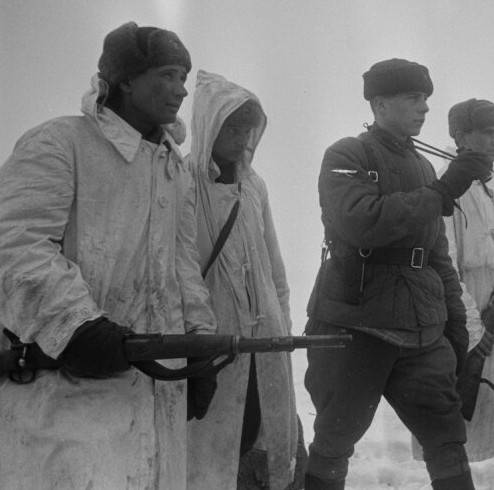
Subsequently, after saturation of the rifle units of the Red Army with weapons of domestic production, captured rifles until the end of the war remained in service with rear units that were not directly involved in hostilities, as well as with signalmen, anti-aircraft gunners, artillerymen and training units.
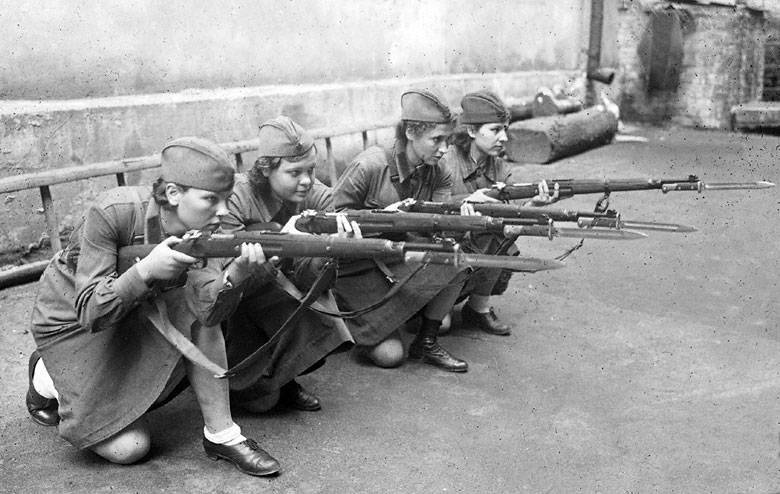
The massive use of captured rifles in combat was hampered by the irregular supply of 7,92 mm cartridges. After the Red Army seized the initiative from the enemy, the Germans, for sabotage purposes, when retreating, began to leave rifle cartridges equipped with high explosives. When an attempt was made to fire such a cartridge, an explosion occurred, and the weapon became unusable for further use, and the shooter could be injured or even die. After such incidents became regular, an order was issued prohibiting the use of unverified cartridges picked up on the battlefield.
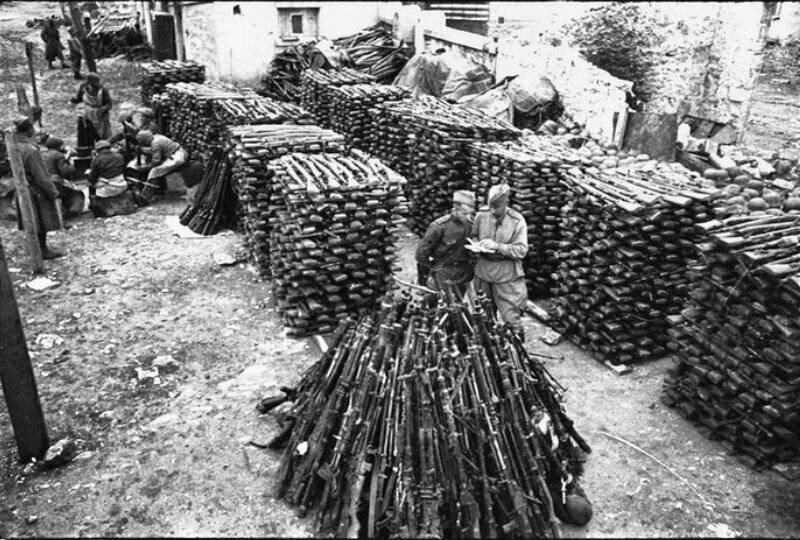
The Red Army soldiers lost a significant part of the captured small arms in battles. Given the fact that rifles captured from the enemy were often not documented for anyone, they were not treated as carefully as regular weapons. Even with minor malfunctions, the Red Army soldiers easily parted with German rifles. The memoir literature describes cases when our soldiers on the offensive, unable to transfer the small arms thrown by the Germans to the trophyers, crushed them tanks or detonated along with the ammunition to be destroyed.
According to archival data, in the post-war period, more than 3 million German rifles suitable for further use were found in Soviet warehouses. In fact, many more were captured, but not all rifles were taken into account and handed over to trophy brigades, officially formed in early 1943.
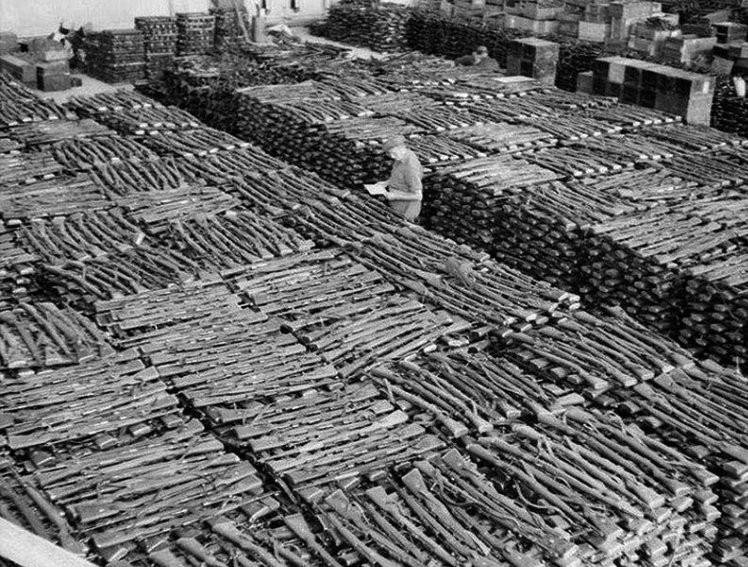
After the K98k rifles arrived at the collection points for captured weapons, they were sent to the rear to the enterprises engaged in troubleshooting and repair. If necessary, trophy rifles suitable for further use were repaired, after which they were taken into account and preserved. In addition to rifles, our troops captured about 2 billion 7,92-mm rifle cartridges, and the German K98k, transferred to storage bases, became a reserve in case of a new war.
Shortly after the end of World War II, the Soviet Union handed over some of the captured German weapons to the Eastern European allies. A large batch of captured K98k was sent to the Communist People's Liberation Army of China, which is waging an armed struggle with the National Revolutionary Army of the Kuomintang. Taking into account the fact that in China since the 1930s, the licensed production of German 7,92-mm rifles and cartridges has been carried out, there were no difficulties with the development of the K98k delivered from the USSR. A significant number of K98k rifles during the Korean War were in the DPRK armed forces and at the disposal of Chinese volunteers. The next major armed conflict, where captured German K98k were spotted, was the Vietnam War. In the early 1960s, the USSR and the PRC donated tens of thousands of K98k rifles and the required number of cartridges to the authorities of the Democratic Republic of Vietnam. In addition, rifles that belonged to the Wehrmacht in the past were supplied to Arab countries and were used in wars with Israel.
Even taking into account the fact that the Soviet Union very generously supplied its allies with captured German rifles on a gratuitous basis, a lot of them remained in warehouses after the collapse of the USSR. Some of the rifles were sent for recycling, and some were put up for sale as a hunting weapon.
A hunting carbine chambered for the original 7,92 × 57 mm Mauser cartridge - known as KO-98M1. KO-98 is a carbine re-barrel chambered for .308 Win (7,62 × 51 mm). VPO-115 - carbine chambered for .30-06 Springfield (7,62 × 63 mm). For shooting from the VPO-116M carbine, the .243 Winchester cartridge (6,2 × 52 mm) is used.
In addition to the store K98k, in the second half of the war, the Red Army captured G41 (W) / G43 self-loading rifles and FG42 automatic rifles. However, when preparing this publication, I was unable to find information about their use in the Red Army. Apparently, if automatic and self-loading German rifles were used by our fighters against their former owners, then it was irregular and for a short time. With a much higher probability, semiautomatic devices could be found among partisans or in service with reconnaissance and sabotage groups thrown into the German rear. What can we say about the rather capricious German semi-automatic and automatic rifles, when even our self-loading SVT-40 were not popular among the troops. This was due to the fact that, in comparison with store rifles, semi-automatic rifles required more careful maintenance and competent operation. But oddly enough, German automatic rifles were used during the war in Southeast Asia. Several FG42s were repulsed by the Americans from the Viet Cong.
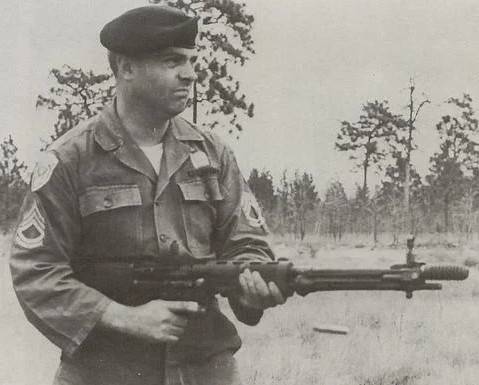
American soldier with an FG42 automatic rifle
Although the StG 44 was not the height of perfection, for its time this machine was a fairly effective weapon. Despite the fact that the StG 44 was often criticized for the insufficient strength of stamped parts and a complex design compared to submachine guns, German machine guns for an intermediate cartridge were popular with our fighters.
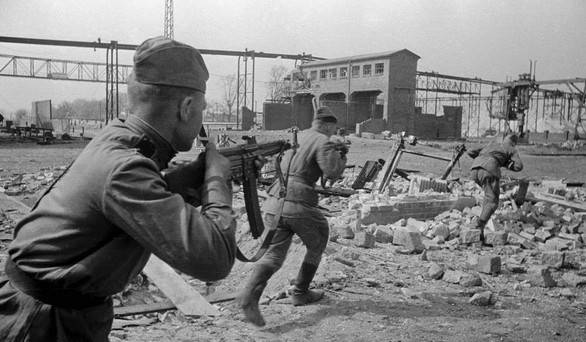
There are many photos on the network, dated from the second half of 1944 - early 1945, in which Soviet soldiers are armed with StG 44.
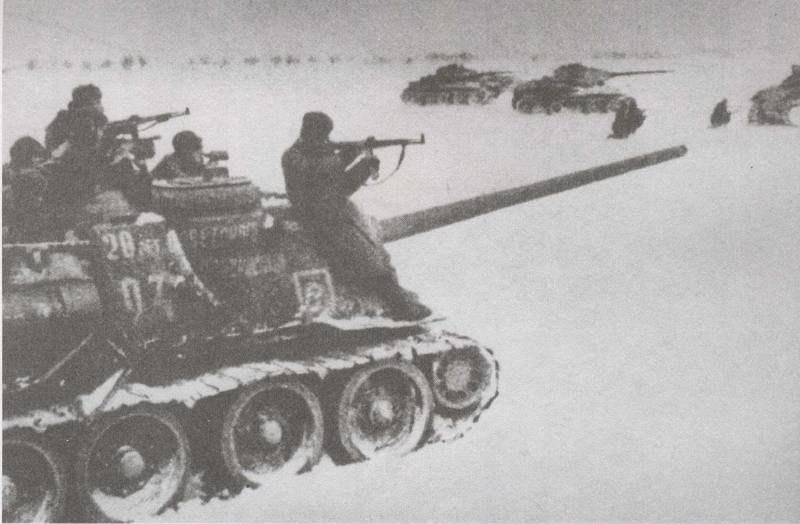
After the end of World War II, StG 44 assault rifles were in service in a number of countries of the socialist bloc. So, machine guns produced in the Third Reich were used by the armies of Hungary and Czechoslovakia until the late 1950s, and by the People's Police of the GDR until the early 1970s. The first major armed conflict involving the StG 44 was the Korean War. A number of German assault rifles were used by the Viet Cong.
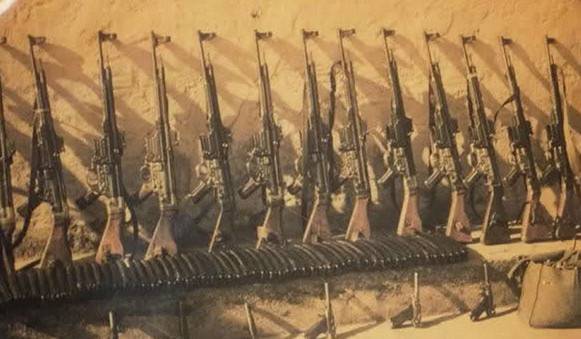
StG 44 captured by the French in Algeria
In the early 1960s, French troops fighting insurgents in Algeria captured dozens of StG 44s and their cartridges bearing the mark of the Czechoslovakian ammunition manufacturer Sellier & Bellot.

StG 44 assault rifles were also supplied to the national liberation movements of "black" Africa. In the photographs taken in the 1970-1980s, one can see militants of various armed groups with StG 44. Cases of the use of StG 44 by Syrian militants have been recorded. Apparently, these assault rifles in storage were seized in 2012 along with other obsolete weapons.
To be continued ...
Articles from this series:
Use of captured German pistols in the USSR
The use of German captured submachine guns in the USSR





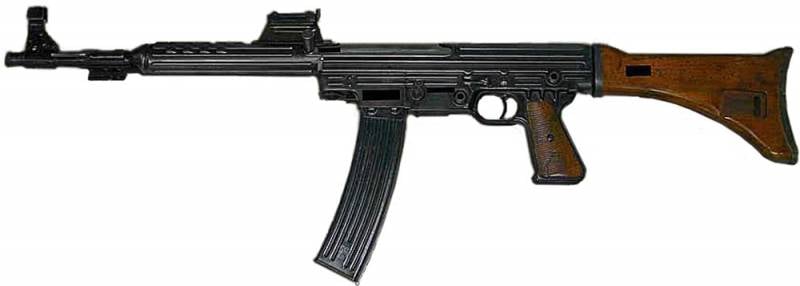

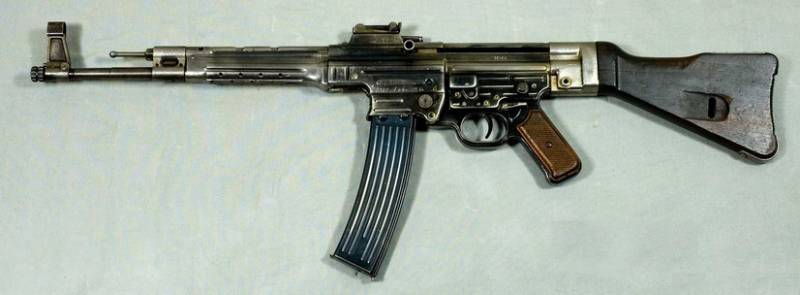
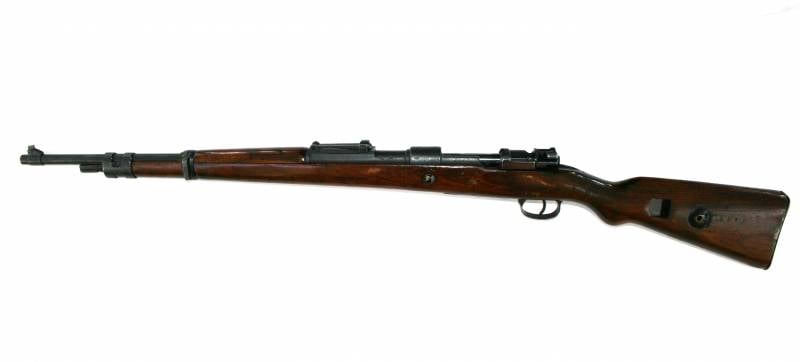
Information